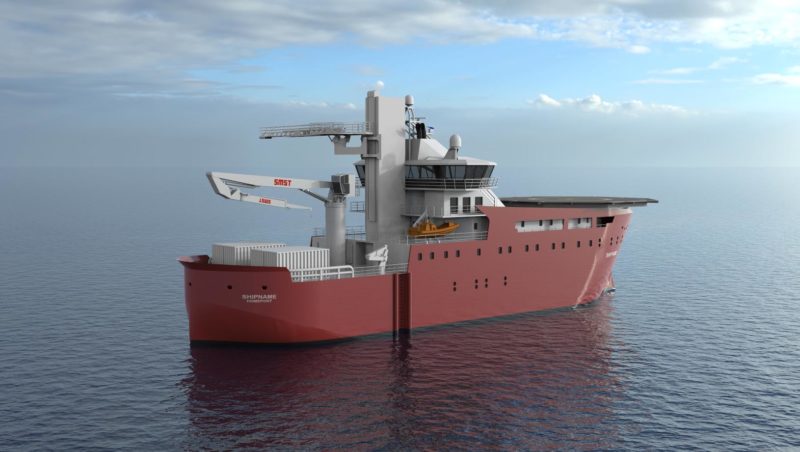In the offshore wind energy business, one of the biggest questions is when U.S. shipyards will step up and build a new generation of support vessels.
ABS and Vard offered one prospect, when the classification society announced it had awarded an “approval in principle” for a Jones Act-compliant version of Vard’s 4 07 service operation vessel (SOV) – a major step up from the first generation of crew transfer vessels for U.S. wind operations.
Vessels with dynamic positioning and stabilized gangways – commonly known in Europe as walk-to-work designs – will be needed for operations and maintenance if the large wind turbine arrays now envisioned by developers are built from southern New England to Virginia.
With longer endurance and more accommodations than day-boat crew transfer vessels, the SOV class will be critical to operations and maintenance of wind arrays, according to ABS, which awarded the approval to Vard at the 40th annual International WorkBoat Show in New Orleans in early December.
Vard says its design will be environmentally friendly with a focus on low fuel consumption and ease of construction. A state-of-the-art hull form designed for all weather conditions is combined with a propulsion package for economical steaming, enhanced seakeeping abilities, and excellent station keeping performance.
“The vessel is optimized to reduce motions and accelerations in all degrees of freedom with the aim to increase operability and comfort,” according to ABS. That will be critical for maintaining technician crews at peak performance in the northwest Atlantic.
ABS says it can class the design as Maltese Cross A1, OFFSHORE SUPPORT VESSEL (WIND-SC), Maltese Cross AMS, Maltese Cross ACCU, DPS-2, HAB(WB.)
“ABS is supporting innovation in the development of alternative energy systems all over the world and it is a real pleasure to be helping to deliver such an important vessel here in the US,” Matthew Tremblay, senior vice president of ABS Global Offshore, said in announcing the approval. “ABS’ industry-leading experience in offshore oil and gas allows us to offer practical support to the emerging US offshore wind industry.”
“With our track record in SOV and offshore vessel designs and ABS’ record in the offshore sector, working together to deliver this project seemed like a natural fit,” said Darren Truelock, vice president of Vard Marine’s Houston, Texas, division. “We already have experience supporting yards worldwide to construct our offshore vessel designs, so it is with great enthusiasm that we now start on this exciting journey with ABS in the U.S.”
Meanwhile investment is continuing in smaller U.S.-built crew transfer vessels to serve offshore wind projects in their early stages of construction. Offshore wind farm support company Atlantic Wind Transfers of Rhode Island – operators of the Atlantic Pioneer, the first U.S.-flag crew transfer vessel – announced they had signed an order for two state-of the-art Chartwell 24 crew transfer vessels (CTVs), developed by Chartwell Marine.
The vessels, to be deployed in support of new wind farms off the East Coast, will be built by Blount Boats, the Warren, R.I., company that built the Atlantic Pioneer, with delivery scheduled for 2020.
“This is another major milestone for us as we expand our operation and aim to support the local supply chain along the East Coast of the United States,” said Charles Donadio, CEO of Atlantic Wind Transfers, whose company carries crews out to the Block Island Wind Farm, the first U.S. commercial offshore wind energy installation.
Atlantic Wind Transfers and Blount are betting that their location on Narragansett Bay and experience at Block Island can be parlayed into making Rhode Island a major service center for the industry.




